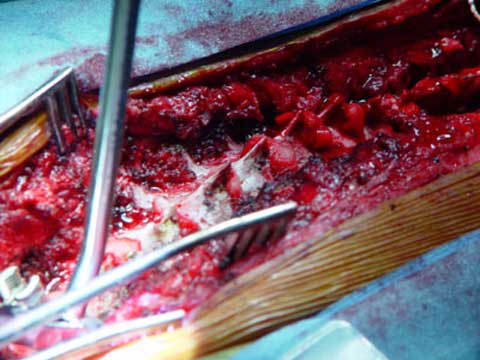The History of Scoliosis Surgery
For video of scoliosis surgery click the checkbox below. (WARNING VERY GRAPHIC)
The first scoliosis surgeries were conducted by a French surgeon named Jules Rene Guerin (1801-1886) in 1865. In an attempt to reduce the visible effects of the scoliosis and straighten the spinal column, he severed the muscles and tendons of 1,349 patients. This resulted in horrific effects and lead to what many consider to be the first recorded instance of medical dispute and one of the most famous orthopedic lawsuits.
Dr. Russel Hibbs performed the first spinal fusion scoliosis surgery at the New York Orthopedic Hospital in 1914. The inventor of spinal fusion surgery; he had been performing the operation for three years before applying it to the treatment of scoliosis. An early critic of spinal surgery, Arthur Steindler (1878-1959) developed a method of treatment with emphasis on the “re-establishment of compensation, which had been lost, by the development of compensatory curves of adequate degree to realign the body: shoulders square over pelvis, pelvis square over ankles”. This method is similar to the CLEAR Institute’s method.
By 1941, spinal fusion operations for idiopathic scoliosis were common. Shands of the Alfred I. duPont Institute and his fellow researchers studied more than 400 cases. Hibbs-type fusion procedures were performed in all cases, but most surgeons (60%) used supplemental bone graft (often from the tibia). An approximately 25% final curve correction was achieved, and an overall 28% pseudarthrosis (non healing of the area of fusion) rate was noted.
20 years later Paul Harrington introduced the spinal instrumentation system. Harrington’s original concept was instrumentation without fusion, but eventually this changed to spinal fusion in conjunction with Harrington rods. The Harrington Rod procedure was developed in the 1950’s. A single inflexible steel rod secured the straightened spine, and bone was grafted from the patient’s hip and placed into the vertebral spaces to stimulate a fusion. This surgery was performed through the back and lead to loss of all flexibility in the full length of the fusion. The surgery lasted between 8 and 12 hours and recovery was slow and difficult. The patient would be confined to bed for up to 3-6 months in a full body cast from the neck to below the hips, and another six months in a hard plastic jacket similar to today’s Wilmington brace.
Wilmington Brace
Some patients experienced problems with low back and leg pain due to degeneration of the discs below the fusion post scoliosis surgery. By the mid-70s, the Harrington method was often performed using two rods to correct both upper and lower curves.
Cotrel & Dubousset developed the pedicle screw system. It was the first system that allowed for de-rotation of the vertebral bodies which corrected in the sagittal plane in addition to the lateral deviation. Although correction rates achieved by posterior pedicle-screw are good overall, the rate of post scoliosis surgery complications is very high. One study found that 68% of patients experienced minor or major severe complications.
There are currently several alternatives to scoliosis surgery. Some combine soft bracing and exercise techniques such as the Spinecor bracing system. There are other physiotherapeutic treatment systems which apply isometric and other exercise techniques like The Schroth Method. Since 2002 the CLEAR Institute has implemented innovative treatment methods that correct scoliosis without the use of bracing or surgery. This group of 42 highly trained professionals (in the US) have implemented a chiropractic and physiotherapeutic treatment system that combines in-office treatment with at-home exercises and rehabilitation designed to keep forward momentum of treatment when the patient is not in the office. Their treatment method includes: spinal adjustments, rehabilitative procedures, specific isometric exercises, proprioceptive neuromuscular re-education, cervical and lumbar lordosis restoration, muscle and ligament rehabilitation, and vibration therapy. The treatment model can be effectively used with scoliosis bracing. This alternative to scoliosis bracing and surgery is a favorable option to anyone with scoliosis. However, there are still some cases of scoliosis that have no alternative but surgery (i.e. curves of very large size that creates respiratory stress or heart conditions, or aggressive juvenile scoliosis).
SOURCE
For more information contact Strauss Scoliosis Correction to see if the our approach is right for you.



